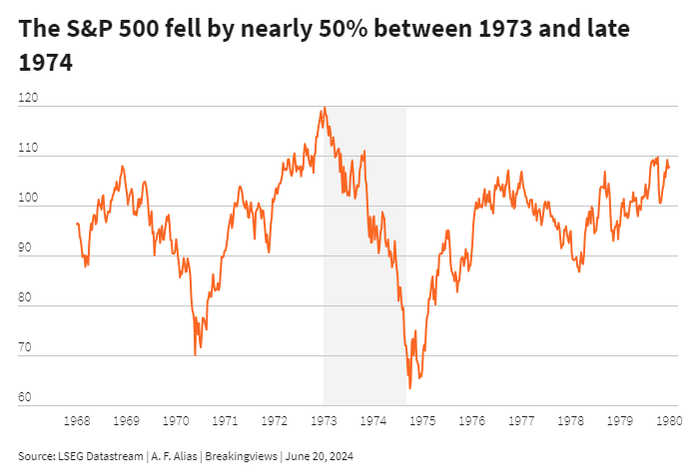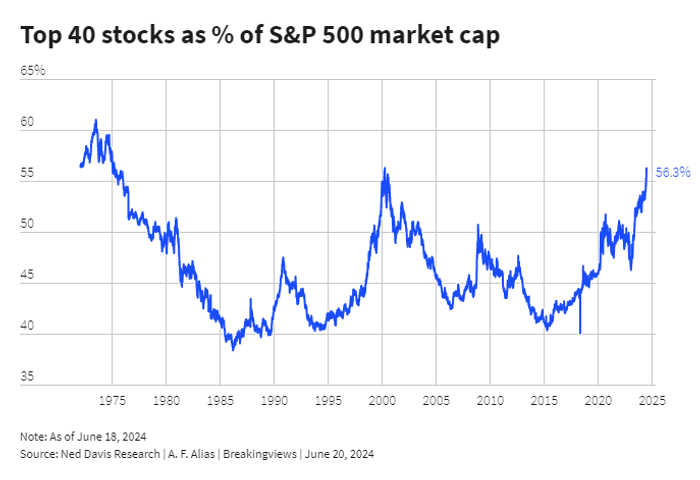Published 17:52 IST, June 22nd 2024
A warning from history about large-cap stock booms
The 40 largest stocks in the S&P 500 currently account for 56% of the index, compared to around 60% in 1973, according to Ned Davis Research.
- Markets
- 5 min read

Nifty history. Fifty years ago, the U.S. stock market was in turmoil. Between January 1973 and September 1974, the S&P 500 Index fell by nearly 50%. With the benefit of hindsight, this decline was the second leg of a bear market which commenced in late 1968. However, stocks had rallied from the summer of 1970, led by a small group of large, high-quality companies, before suffering a more severe collapse. Today, as the U.S. equity market rests on the continued success of a handful of giants, this earlier period appears particularly instructive.
The short-lived boom of the early 1970s started with the demise of highly speculative stocks in the late 1960s. After inflation picked up and interest rates climbed, technology, computer leasing and other small-cap growth companies dropped out of fashion. Once inflation peaked in 1970, the market rallied. This time, however, investors were more cautious. They still wanted exposure to growth but congregated in higher quality, large-cap stocks of companies with proven track records.
Contemporary commentators dubbed the small number of favoured names as “vestal virgins”, “sacred cows” and “religion stocks”. Posterity knows them as the Nifty Fifty. Different Wall Street firms disagreed about the group’s exact membership. But it included technology firms like Eastman Kodak, Polaroid and Xerox, consumer goods companies such as Avon Products, drugmakers Johnson & Johnson and Merck, and other established businesses, such as fast-food chain McDonald’s.
What these companies had in common was their ability to deliver above-average growth in sales and earnings. According to the investor Jeremy Grantham, who observed the boom from a small-cap value investment firm in Boston, the Nifty Fifty had produced abnormally few disappointments in prior years.
The investment world at the time was undergoing a profound change. Private investors no longer dominated the stock market. By 1972, institutional managers held around 45% of the shares traded on the New York Stock Exchange. Bank trust departments, of which the largest was Morgan Guaranty, controlled the United States’ rapidly growing pensions pot. Their managers favoured the liquidity provided by the largest stocks. They regarded the Nifty Fifty as “one decision” stocks: the visibility of future earnings was seen as so assured that, once purchased, they need never sell the shares.
No price was too high for proven growth stocks. As money flowed from small investors into institutional funds, a remarkable two-tier market opened. By early 1973, the median stock on the NYSE was trading at a multiple of 11.5 times earnings, while the average price-earnings ratio for Kidder Peabody’s list of the top 50 stocks stood at heady 48. An institutional investor told the New York Times that “too many analysts spend too much time worrying about these multiples and not enough time examining the uniqueness of the company ... we’re talking about companies where the ability to create and innovate is of a more permanent nature ... Go with the best.”
The rising concentration of the market in a mere handful of stocks prompted a Senate investigation. The head of trust operations at First National City Bank (which later became Citibank) assured the Committee that in placing “our primary investment emphasis on large, growing, advanced technology or consumer-oriented companies in the so-called ‘top tier’” his firm was exercising its best judgement in line with its fiduciary responsibilities to clients.
Barton Biggs, who joined Morgan Stanley in mid-1973, recalled that these top-tier stocks kept grinding higher even as the rest of the market faltered. “As the year progressed, the Nifty Fifty got narrower and narrower, and by the late summer, only a small number of the biggest and best were holding up.” The selloff started with an oil embargo on the United States by the Organization of the Petroleum Exporting Countries. The following year Franklin National Bank collapsed, and President Nixon resigned in the wake of the Watergate scandal. Rising inflation brought tighter monetary policy. In the sharp recession that followed, the U.S. unemployment rate hit 9%.

In the stock market selloff, the Nifty Fifty underperformed, declining by 60% according to Ned Davis Research. As one commentator famously put it, they were taken out and shot one by one. Shares in Polaroid and Avon, which suffered specific problems, fell respectively by 90% and 86% from their peaks. But most of the other growth stocks cratered without any serious earnings disappointments. For instance, McDonald’s and Xerox both declined 72%.
According to Biggs, most of the damage was done in 18 months. When the stock market took off again in 1975, small-cap and value stocks led the advance. Morgan Guaranty, formerly the keenest proponent of the top tier, had become a heavy seller of large growth stocks which it now deemed to offer little protection against inflation. It took 10 years on average for the Nifty Fifty stocks to get back to their previous highs in nominal terms, even though in most cases their earnings kept growing.
Today’s stock market stars are a different group of very large companies, led by tech giants which investors expect to profit from the boom in artificial intelligence. Nvidia, which this week displaced Microsoft as the world’s largest company by market capitalisation, has trebled in value to $3.3 trillion since the beginning of the year. Yet just as in the early 1970s, the market depends on a select group of companies that everyone wants to own. The 40 largest stocks in the S&P 500 currently account for 56% of the index, compared to around 60% in 1973, according to Ned Davis Research.

Interviewed in April 1974, Benjamin Graham despaired of expecting any rationality on Wall Street. Warren Buffett’s mentor could not understand how speculative behaviour could have returned so quickly to the stock market after the crash of the late 1960s. But Graham had always been sceptical of buying stocks on elevated multiples based on projected future earnings. In his view, such investments lacked an adequate margin of safety. As he had written four decades earlier, “history constantly reminds us that there is no absolute ‘visibility’ of prospects in an uncertain world.”
Updated 17:52 IST, June 22nd 2024